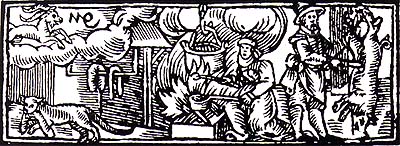History of Slaughterhouse in Český Krumlov
First written mentions on slaughterhouse (Cz. šlechtáta) appeared in 16th century. It was situated near Masna street with its meat market. According to the butcher´s guild privilege granted by Jošt von Rosenberg, a butcher that brought a cattle for slaughter had to take it first to the šlechtáta to have it checked out by the head of butcher´s guild. If it was considered healthy, the butcher was able to slaughter it and sell the meat. Big cattle "shall not be slaughtered on the square neither at meat markets neither at home neither any place else, only at šlechtáta". If the rule was violated, the offender had to pay 20 pennies to the ruler´s chamber and 1 penny to the municipal council.
The access to šlechtáta led from Radniční street, approximately in between today´s houses no. 100 and 101. The gate would be locked in the evening and keys placed at the police station. Those that would have some cattle registered for slaughter the next day picked up the keys in the morning. The gate used to stay unlocked in the 19th century for an easy access to water in case of fire. Šlechtáta itself was rectangle-shaped with a little slaughter bridge of 7 x 13 meters placed by the river. The bridge was paved and held a water pump. A small blood outflow groove led out of the bridge into the Vltava river. As the written sources say, it was not usually cleaned, therefore the neighborhood, especially during the summer season, suffered of an unbearable smell. The whole area was surrounded by a wall so that the cattle could not sneak out. A so-called 2.4 meter broad Water Gate used to stand in between the slaughter bridge and today´s house no. 101 in Radniční street. There was another gate leading out of šlechtáta into the neighboring garden and owned by the butcher´s guild which provided passage through Ostrov into Široká street. Besides its disgusting appearance and smell, šlechtáta used to be the place where "under the darkness, sins are being committed in the corner by that gate". Economic inspection office asked the municipal council to have the town lit up with street lamps "in order to reach a better morality at least in public areas".
Given unbearable hygienic conditions, the municipal council was forced to move the slaughterhouse to the outskirts. A new slaughterhouse project was drawn up in 1913 and put into operation at Špičák no. 194 in 1914. The building was owned by the butchers' trade union and became municipal property in 1942.
(ds)


